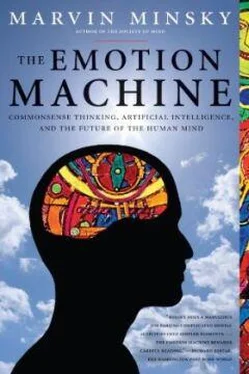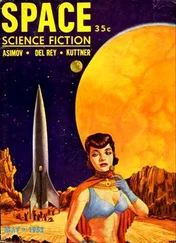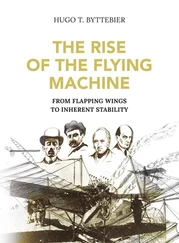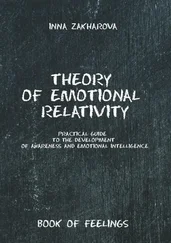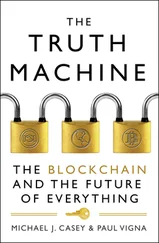Marvin Minsky
The Emotion Machine: Commonsense Thinking, Artificial Intelligence, and the Future of the Human Mind (draft)
Nora Joyce, to her husband, James: "Why don't you write books people can read?"
I hope this book will be useful to everyone who seeks ideas about how human minds work, or wants suggestions about better ways to think, or who aims toward building smarter machines. It should be useful to readers who want to learn about the field of Artificial Intelligence. It should also be of interest to psychologists, neurologists, computer scientists, and philosophers because it develops many new ideas about the subjects those specialists struggle with.
We all admire great accomplishments in the sciences, arts, and humanities—but we rarely acknowledge how much we achieve in the course of our everyday lives. We recognize the things we see, we understand the words we hear, and we remember things that we’ve experienced so that, later, we can apply what we’ve learned to other kinds of problems and opportunities.
We also do a remarkable thing that no other creatures seem able to do: whenever our usual ways to think fail, we can start to think about our thoughts themselves— and if this “reflective thinking” shows where we went wrong, that can help us to invent new and more powerful ways to think. However, we still know very little about how our brains manage to do such things. How does imagination work? What are the causes of consciousness? What are emotions, feelings, and thoughts? How do we manage to think at all?
Contrast this with the progress we’ve seen toward answering questions about physical things. What are solids, liquids, and gases? What are colors, sounds, and temperatures? What are forces, stresses, and strains? What is the nature of energy? Today, almost all such mysteries have been explained in terms of very small numbers of simple laws—such as the equations discovered by such physicists as Newton, Maxwell, Einstein, and Schrödinger.
So naturally, psychologists tried to imitate physicists—by searching for compact sets of laws to explain what happens inside our brains. However, this book will argue that this quest will fail because no simple such set of laws exists, because every brain has hundreds of parts, each of which evolved to do certain particular kinds of jobs; some of them recognize situations, others tell muscles to execute actions, others formulate goals and plans, and yet others accumulate and use enormous bodies of knowledge. And though we don’t yet know much about how each of those hundreds of brain-centers works, we do know that their construction is based on information that is contained in tens of thousands of inherited genes—so that each brain-parts works in a way that depends on a somewhat different set of laws.
Once we recognize that our brains contain such complicated machinery, this suggests that we need to do the opposite of what those physicists did: instead of searching for simple explanations, we need to find more complicated ways to explain our most familiar mental events.
For example, the meanings of words like “feelings,” “emotions,” or “consciousness” seem so natural, clear, and direct to us that we cannot see how to start thinking about them. However, this book will argue that each of those words attempts to describe the effects of large networks of processes inside our brains. For example, Chapter 4 will demonstrate that “consciousness” refers to more than twenty different such processes!
It might appear to make everything worse, to change some things that looked simple at first into problems that now seem more difficult. However, on a larger scale, this increase in complexity will actually make our job easier. For, once we split each old mystery into parts, we will have replaced each old, big problem with several new and smaller ones—each of which may still be hard, but no longer will seem unsolvable. Furthermore, Chapter 9 will argue that regarding ourselves as complex machines need not diminish our feelings of self-respect, and should enhance our sense of responsibility.
To start dividing those old big questions into smaller ones, this book will begin by portraying a typical brain as containing a great many parts that we’ll call “resources.” {1} How this Book handles Quotes and Citations Each statement in quotation marks is something said by an actual person; if it also has a publication date, the source will be in the bibliography. Marcel Proust 1927: “Each reader reads only what is already inside himself. A book is only a sort of optical instrument which the writer offers to let the reader discover in himself what he would not have found without the aid of the book." A statement without quotation marks is a fictional comment a reader might make. Citizen: If our everyday thinking is so complex, then why does it seem so straightforward to us? Most references are conventional bibliographic citations, such as Schank 1975: Roger C. Schank, Conceptual Information Processing , Elsevier Science Publishers 1975. ISBN: 0444107738. Some references are to pages on the World Wide Web. Lenat 1998: Douglas B. Lenat, The Dimensions of Context Space , at http://www.cyc.com/doc/context-space.pdf Some other references are to newsgroups on the web, such as McDermott 1992: Drew McDermott. In comp.ai.philosophy, 7 Feb 1992. To access such newsgroup documents (along with the context in which they were written) one can make a Google search for “comp.ai.philosophy McDermott”. Also I will try to maintain copies of these on my website at www.emotionmachine.net , and invite readers with questions and comments to send them to me by using that web site. Note this book uses the term resource where my earlier book, The Society of Mind, used agent . I made this change because too many readers assumed that an “agent” is a personlike thing (like a travel agent) that could operate independently, so that mental agents could cooperate in much the same ways that people do. On the contrary, most resources are specialized to [do] certain kinds of jobs for certain other resources , and cannot directly communicate with most of the person’s other resources. For more details about how these two books relate, see the article by Push Singh 2003, who helped to develop many of the ideas in this book.

We’ll use this image whenever we want to explain some mental activity (such as Anger, Love, or Embarrassment) by trying to show how that state of mind might result from the activities of a certain collection of mental resources. For example, the state called “Anger” appears to arouse resources that make us react with unusual speed and strength—while suppressing resources that we otherwise use to plan and act more prudently; thus Anger replaces your cautiousness with aggressiveness and trades your sympathy for hostility. Similarly, the condition called “Fear” would engage resources in ways that cause you to retreat.
Citizen: I sometimes find myself in a state where everything seems cheerful and bright. Other times (although nothing has changed) all my surroundings seem dreary and dark, and my friends describe me as “down” or “depressed.” Why do I have such states of mind—or moods, or feelings, or dispositions—and what causes all of their strange effects?
Some popular answers to this are, “Those changes are caused by chemicals in the brain,” or “They result from an excess of stress,” or “They come from thinking depressing thoughts.” However, such statements say almost nothing about how those processes actually work—whereas the idea of selecting a set of resources can suggest more specific ways in which our thinking can change. For example, Chapter 1 will begin by thinking about this very familiar phenomenon:
Читать дальше
